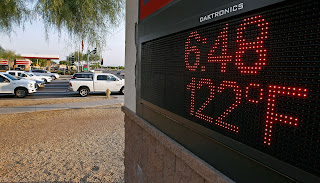Too Hot To Handle
They're roasting. They're poor and they're vulnerable. No, they're not Honduran or Guatemalan. They're Americans.
Yesterday I wrote about how parts of Central America are becoming increasingly less habitable. Heatwaves, severe storm events, droughts, floods of increasing frequency, duration and severity and their knock-on effects, especially food insecurity, are causing the poor to migrate for the sake of survival.
Americans, some of them anyway, are all too familiar with the impacts of climate change. What they have in common is that they tend to be poor to low-income and live in southern states, especially Florida and Arizona.
Mario Wilcox won’t set out in the summer without an emergency kit in his car trunk: a cooler with an ice pack and a blanket. He learned this improvised life saver from his time in the Iraq and Afghanistan wars; ice and a wet cloth can cool down an overheated body. Now he finds it vital in the intensifying heat of Fort Pierce, Florida, and especially his heat-stressed neighborhood.
More than 2,000 miles away in Phoenix, Arizona, Grace Salinas monitors the street outside her window in a public housing complex when summer temperatures reach triple digits. A community leader in the area southwest of downtown, Salinas stocks cold water bottles for anyone she sees struggling with the heat, a situation growing more common each year.
Phoenix now logs 140 days with temperatures over 100 F each year. But it's "dry heat." That ameliorates the problem but only to a certain point. Florida, by contrast, doesn't get as much heat but it has plenty of that extra factor, humidity.
High heat plus high humidity is a lethal combination. The human body uses the evaporation from sweat for cooling. The greater the humidity, the less effective the evaporation effect. There's a point, it's called Wet Bulb 35, where temperatures reach 35 C or higher and humidity nears 100% that will kill even a young, healthy person sitting at rest in the shade. The body becomes unable to shed heat from the core and so the person cooks from the inside out.
Poor communities are bearing the brunt of sickening heat in these states, an analysis by Columbia Journalism Investigations and the Center for Public Integrity found. Federal data capturing most emergency room visits and hospitalizations in Arizona and Florida reveal higher rates of heat-related illnesses in areas with less income. The data, never before made public at the ZIP code level, also show that the highest rates of heat-related illnesses are in neighborhoods with a history of racial segregation. Experts say racist policies of the past created conditions, never corrected, that make heat more dangerous for people there today.
A complicating phenomenon of global warming is overnight temperatures. Daytime temperatures, for example, may be 3 degrees warmer than normal but night time temperatures 5 or 6 degrees warmer than normal. Buildings don't cool down. Heat isn't dissipated but builds for the following day. This translates into more severe heatwaves of longer duration.
Paris is the poster boy for the lethal effect of extended heatwaves. Many of the elderly live in small apartments in 18th and 19th century buildings that were never designed for high temperatures. What the French found is that there were many who could survive for a couple of days but succumbed as the heatwave continued.
The 2020s are expected to be a decade of a new heating phenomenon called "climate departure" in which traditional climate variability, i.e. cold years and hot years, is replaced with just a succession of only hot years. Seven years ago this was considered merely a theory from a bunch of climate scientists at the University of Hawaii. Since then climate scientists in other countries have come to the same or similar conclusions.
What is going on in Central America and the American south today will come as no surprise to these climate science types. It might be a year or two earlier than they predicted but that's a minor detail.
If climate departure is locked in it will probably be with us for a century, maybe several centuries. There are adaptation measures to reduce the body count, especially in affluent countries, but it's unclear the will exists to implement them.



When the USA had the 1996 Olympics a BBC reporter commented that on his rail journey from Washington DC to Atlanta he had never seen so many trailer/mobile home courts !
ReplyDeleteThey were/are located along the railroad track.
This is the true American dream.
The only thing that separates the USA from it's central American neighbours is it's ability to convince it's citizens that the US is exceptional..
The USA must be the only country where you can fool them all of the time , not just some of the time.
TB
This is another testimony on how Chief Dr Lucky cured my HIV disease. Do you need a cure for your HIV disease? Do you want to be cured from your cancer disease? Or you want to be free from any type of disease. Kindly visit his website https://chiefdrluckyherbaltherapy.wordpress.com/ . He just cured my HIV disease and I’m very grateful to him, he is the only herbalist that can cure you.
ReplyDeleteWhatsApp number : +2348132777335
Via Email : chiefdrlucky@gmail.com
Thank you all for reading,
God bless"